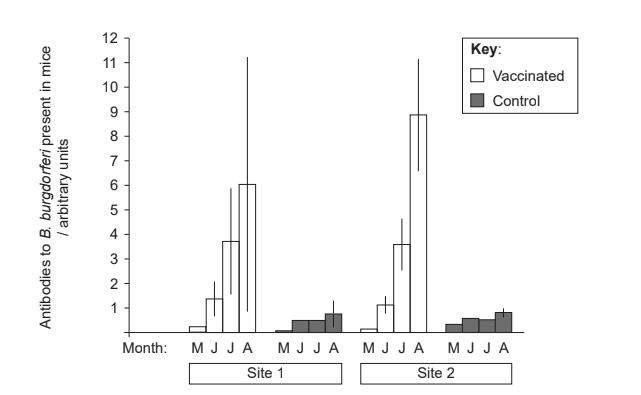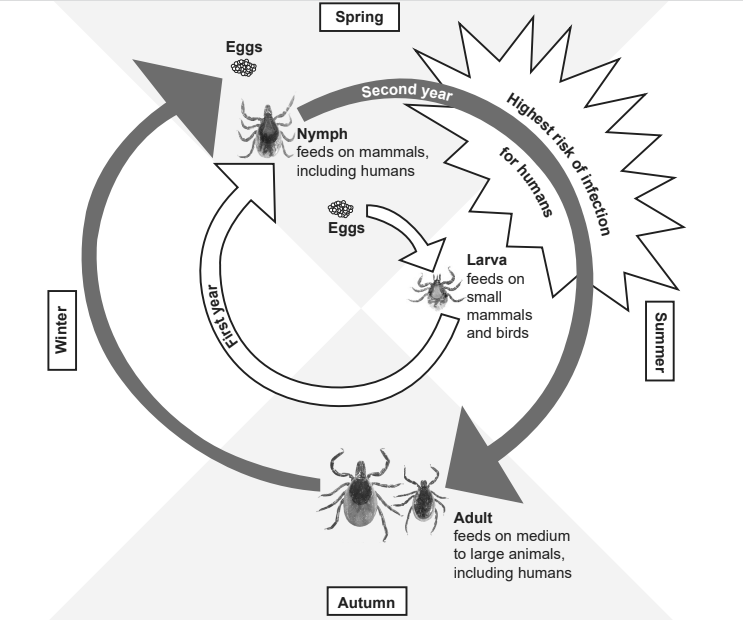The black-legged tick (Ixodes scapularis) is an arthropod which sucks blood from humans and other mammals It is encountered mainly in wooded and semi-wooded areas Some ticks can be infected by the bacterium Borrelia burgdorferi When a tick bites a human, the bacterium is often introduced, causing Lyme disease Lyme disease is a public health problem in North America and, if left untreated, can cause important neurological impairment The diagram represents the two-year life cycle of a tick
State the domain into which ticks are classified. [1]
Using information from the text, identify one possible simple treatment for Lyme disease [1]
Scientists fear that global warming will change the distribution range of ticks The graphs show the developmental stages of ticks throughout seasons in a densely human-populated area of south-eastern Canada, surrounded by woods (circled on the map) Values are already established for 2000 and are predicted for 2080

Identify the month when small birds had the greatest chance of being infected by
B. burgdorferi bacteria in the year 2000 and the month when they would be most likely to become infected according to the 2080 predictions [1]
2000:
2080:
Using the life cycle diagram and the graph for the year 2000, analyse the distribution of adult ticks throughout the different seasons. [2]
Evaluate the effect of the change in distribution of the different life stages of ticks on the spread of Lyme disease in south-eastern Canada [3]
White-footed mice (Peromyscus leucopus) in eastern North America’s wooded areas often host B. burgdorferi bacteria To determine whether bacterial transmission from mice to tick nymphs could be prevented, mice were vaccinated with antigens from Lyme disease-causing
B. burgdorferi. Scientists captured wild mice at two different sites in the woods once a month, over 4 months Each time, they measured the levels of antibodies to B. burgdorferi present in the captured and re-captured mice, inoculated all of them, and released them into the woods The control group was not vaccinated with B. burgdorferi antigen

(i) State the reason for performing the experiment in the months of May to August [1]
(ii) Suggest possible reasons for the observed pattern of presence of antibodies in vaccinated mice [3]
The summer after vaccination, the prevalence of B. burgdorferi infection in tick nymphs collected on mice from the two sites was measured

g. Analyse the data on the state of infection of tick nymphs with B. burgdorferi in control and vaccinated mice [2]
h. Using all the data, discuss whether inoculating mice with the antigen to B. burgdorferi could be an effective method of controlling the spread of Lyme disease. [3]
▶️Answer/Explanation
Ans:
a eukaryote
b antibiotics / named antibiotics
c «2000» August AND «2080» July Both required.
d a adults present through autumn and winter «according to the life cycle diagram»
OR
some adults «must» survive winter «despite graph suggesting zero»
✔b adults peak in October «& November»/in autumn/between September and December
c adults die after laying eggs in winter/beginning of spring
d smaller peak/10% versus 55% peak/smaller numbers of adults in April/spring e adults absent from June to September/summer Each mark point, requires month or season. Jan – Mar = winter Apr – Jun = spring Jul – Sep = summer Oct – Dec = autumn = fall Do not accept that there are the lowest number or no adults in winter.
e a nymphs present through most of year/longer period/from March to November/through spring and summer «so more risk of infection» b more adults in winter/in January/February so more risk of infection then c infection will be possible through more/most months of/throughout the year d Lyme disease likely to/will increase
f i because nymphs are present/numbers of nymphs rise «in these months» OR build up immunity/antibodies in mice before nymphs «peak» Ignore references to larvae. 1
f iia low antibody level initially as mice not previously exposed to antigen/bacteria b vaccination causes antibody production/development of immunity c increased proportion of mice have been vaccinated in each successive month d second vaccination/booster shot increases antibody level/speeds up antibody production e memory cells produced so greater/faster antibody production f many/rising numbers of nymphs which may spread the bacteria/antigens to mice
g a at Site 1 there is little/no significant difference in the proportion of infected nymphs/numbers of infected and uninfected nymphs collected from both control and vaccinated mice
✔g b at Site 2 the proportion of infected nymphs is lower in those collected from vaccinated than control mice
ORat Site 2 «significantly» more nymphs are not infected from vaccinated than control mice
✔g cat both sites there are fewer infected than uninfected nymphs in those collected from both vaccinated and control mice
g d proportion of infected nymphs is lower at Site 1 than Site 2 in nymphs collected from both control and vaccinated mice
OR22% of control mice and 23% of vaccinated mice with infected nymphs at Site 1 AND 39% of control mice and 29% of vaccinated mice with infected nymphs at Site 2
✔h a Site 2 suggests that vaccination could reduce «nymph» infection rate «so method might be effective»
h b Site 1 suggests that vaccination does not reduce «nymph» infection rate «so method probably not effective»
h c effective «to some extent» as vaccination increases antibodies/immunity in mice
h d high antibody levels needed/ many mice need to be vaccinated «for the
method to be effective»
h e some nymphs are still infected / «absolute» numbers «rather than proportions» of infected nymphs are similar in those collected from control and vaccinated mice
h f there are other hosts/mammals/birds
h g difficult/expensive «to vaccinate many small mammals/mice» OR cheaper to use protective clothing/tick repellant/avoid wooded areas/other method

